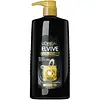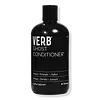What's inside
What's inside
 Key Ingredients
Key Ingredients

 Benefits
Benefits

 Concerns
Concerns

 Ingredients Side-by-side
Ingredients Side-by-side

Water
Skin ConditioningCetearyl Alcohol
EmollientAmodimethicone
Behentrimonium Methosulfate
Behentrimonium Chloride
PreservativeParfum
MaskingDipropylene Glycol
HumectantPhenoxyethanol
PreservativeBenzoic Acid
MaskingTrideceth-6
EmulsifyingPrunus Amygdalus Dulcis Oil
Skin ConditioningHydroxypropyl Guar
Emulsion StabilisingLinalool
PerfumingPotassium Hydroxide
BufferingGlycerin
HumectantBenzyl Salicylate
PerfumingBenzyl Alcohol
PerfumingCetrimonium Chloride
AntimicrobialLimonene
PerfumingHydroxypropyltrimonium Hydrolyzed Wheat Protein
Skin ConditioningAmyl Cinnamal
PerfumingCoumarin
PerfumingCitronellol
Perfuming2-Oleamido-1,3-Octadecanediol
Skin ConditioningAlpha-Isomethyl Ionone
PerfumingArgilla
AbrasivePrunus Amygdalus Dulcis Fruit Extract
Skin ConditioningCI 19140
Cosmetic ColorantCI 15985
Cosmetic ColorantXanthan Gum
EmulsifyingCitric Acid
BufferingSorbic Acid
PreservativeWater, Cetearyl Alcohol, Amodimethicone, Behentrimonium Methosulfate, Behentrimonium Chloride, Parfum, Dipropylene Glycol, Phenoxyethanol, Benzoic Acid, Trideceth-6, Prunus Amygdalus Dulcis Oil, Hydroxypropyl Guar, Linalool, Potassium Hydroxide, Glycerin, Benzyl Salicylate, Benzyl Alcohol, Cetrimonium Chloride, Limonene, Hydroxypropyltrimonium Hydrolyzed Wheat Protein, Amyl Cinnamal, Coumarin, Citronellol, 2-Oleamido-1,3-Octadecanediol, Alpha-Isomethyl Ionone, Argilla, Prunus Amygdalus Dulcis Fruit Extract, CI 19140, CI 15985, Xanthan Gum, Citric Acid, Sorbic Acid
Water
Skin ConditioningCetearyl Alcohol
EmollientBehentrimonium Methosulfate
Cetyl Alcohol
EmollientPanthenol
Skin ConditioningHydrolyzed Soy Protein
HumectantHydrolyzed Rice Protein
Skin ConditioningSaccharum Officinarum Extract
MoisturisingAloe Barbadensis Leaf Juice
Skin ConditioningHydrolyzed Vegetable Protein Pg-Propyl Silanetriol
Skin ConditioningCitrus Aurantium Dulcis Fruit Extract
MaskingCitrus Limon Fruit Extract
MaskingPyrus Malus Fruit Extract
Skin ConditioningSimmondsia Chinensis Seed Oil
EmollientMoringa Oleifera Seed Oil
EmollientTheobroma Cacao Seed Butter
EmollientHydrolyzed Quinoa
Skin ConditioningCamellia Sinensis Leaf Extract
AntimicrobialHelianthus Annuus Seed Extract
Skin ConditioningEthylhexylglycerin
Skin ConditioningTocopherol
AntioxidantStearamidopropyl Dimethylamine
EmulsifyingCetrimonium Chloride
AntimicrobialBehentrimonium Chloride
PreservativePolysorbate 60
EmulsifyingParfum
MaskingCitric Acid
BufferingIsopropyl Alcohol
SolventMagnesium Nitrate
Hydrogenated Castor Oil/Sebacic Acid Copolymer
EmollientTetrasodium EDTA
Sodium Hydroxide
BufferingMagnesium Chloride
Benzyl Alcohol
PerfumingMethylchloroisothiazolinone
PreservativePhenoxyethanol
PreservativeMethylisothiazolinone
PreservativeSodium Benzoate
MaskingPotassium Sorbate
PreservativeDisodium EDTA
Butylphenyl Methylpropional
PerfumingLimonene
PerfumingWater, Cetearyl Alcohol, Behentrimonium Methosulfate, Cetyl Alcohol, Panthenol, Hydrolyzed Soy Protein, Hydrolyzed Rice Protein, Saccharum Officinarum Extract, Aloe Barbadensis Leaf Juice, Hydrolyzed Vegetable Protein Pg-Propyl Silanetriol, Citrus Aurantium Dulcis Fruit Extract, Citrus Limon Fruit Extract, Pyrus Malus Fruit Extract, Simmondsia Chinensis Seed Oil, Moringa Oleifera Seed Oil, Theobroma Cacao Seed Butter, Hydrolyzed Quinoa, Camellia Sinensis Leaf Extract, Helianthus Annuus Seed Extract, Ethylhexylglycerin, Tocopherol, Stearamidopropyl Dimethylamine, Cetrimonium Chloride, Behentrimonium Chloride, Polysorbate 60, Parfum, Citric Acid, Isopropyl Alcohol, Magnesium Nitrate, Hydrogenated Castor Oil/Sebacic Acid Copolymer, Tetrasodium EDTA, Sodium Hydroxide, Magnesium Chloride, Benzyl Alcohol, Methylchloroisothiazolinone, Phenoxyethanol, Methylisothiazolinone, Sodium Benzoate, Potassium Sorbate, Disodium EDTA, Butylphenyl Methylpropional, Limonene
 Reviews
Reviews

Ingredients Explained
These ingredients are found in both products.
Ingredients higher up in an ingredient list are typically present in a larger amount.
This ingredient is a preservative and often used for it's anti-static properties. You'll most likely see this ingredient in hair conditioners.
It does not cause irritation or sensitization in leave-on products at 1-5%.
Behentrimonium Methosulfate is an ammonium salt. It is mainly used to prevent static in haircare products as a surfactant.
Surfactants have differing ends: one side is hydrophilic while the other end is hydrophobic.
Surfactants also help your cleansers remove pollutants more easily from the skin.
Learn more about Behentrimonium MethosulfateBenzyl Alcohol is most commonly used as a preservative. It also has a subtle, sweet smell. Small amounts of Benzyl Alcohol is not irritating and safe to use in skincare products. Most Benzyl Alcohol is derived from fruits such as apricots.
Benzyl Alcohol has both antibacterial and antioxidant properties. These properties help lengthen the shelf life of products. Benzyl Alcohol is a solvent and helps dissolve other ingredients. It can also improve the texture and spreadability.
Alcohol comes in many different forms. Different types of alcohol will have different effects on skin. This ingredient is an astringent alcohol.
Using high concentrations of these alcohols are drying on the skin. They may strip away your skin's natural oils and even damage your skin barrier. Astringent alcohols may also irritate skin.
Other types of astringent alcohols include:
According to the National Rosacea Society based in the US, you should be mindful of products with these alcohols in the top half of ingredients.
Any type of sanitizing product will have high amounts of alcohol to help kill bacteria and viruses.
Learn more about Benzyl AlcoholCetearyl alcohol is a mixture of two fatty alcohols: cetyl alcohol and stearyl alcohol. It is mainly used as an emulsifier. Emulsifiers help prevent the separation of oils and products. Due to its composition, it can also be used to thicken a product or help create foam.
Cetearyl alcohol is an emollient. Emollients help soothe and hydrate the skin by trapping moisture.
Studies show Cetearyl alcohol is non-toxic and non-irritating. The FDA allows products labeled "alcohol-free" to have fatty alcohols.
This ingredient is usually derived from plant oils such as palm, vegetable, or coconut oils. There is debate on whether this ingredient will cause acne.
Due to the fatty acid base, this ingredient may not be Malassezia folliculitis safe.
Learn more about Cetearyl AlcoholThis ingredient is a preservative, antimicrobial, and emulsifier. It is often used in cosmetics for its ability to cleanse, condition, and reduce static.
Cetrimonium chloride is a quaternary ammonium salt, meaning it has a water-soluble structure.
Citric Acid is an alpha hydroxy acid (AHA) naturally found in citrus fruits like oranges, lemons, and limes.
Like other AHAs, citric acid can exfoliate skin by breaking down the bonds that hold dead skin cells together. This helps reveal smoother and brighter skin underneath.
However, this exfoliating effect only happens at high concentrations (20%) which can be hard to find in cosmetic products.
Due to this, citric acid is usually included in small amounts as a pH adjuster. This helps keep products slightly more acidic and compatible with skin's natural pH.
In skincare formulas, citric acid can:
While it can provide some skin benefits, research shows lactic acid and glycolic acid are generally more effective and less irritating exfoliants.
Most citric acid used in skincare today is made by fermenting sugars (usually from molasses). This synthetic version is identical to the natural citrus form but easier to stabilize and use in formulations.
Read more about some other popular AHA's here:
Learn more about Citric AcidLimonene is a fragrance that adds scent and taste to a formulation.
It's found in the peel oil of citrus fruits and other plants such as lavender and eucalyptus. The scent of limonene is generally described as "sweet citrus".
Limonene acts as an antioxidant, meaning it helps neutralize free radicals.
When exposed to air, oxidized limonene may sensitize the skin. Because of this, limonene is often avoided by people with sensitive skin.
The term 'fragrance' is not regulated in many countries. In many cases, it is up to the brand to define this term. For instance, many brands choose to label themselves as "fragrance-free" because they are not using synthetic fragrances. However, their products may still contain ingredients such as essential oils that are considered a fragrance.
Learn more about LimoneneParfum is a catch-all term for an ingredient or more that is used to give a scent to products.
Also called "fragrance", this ingredient can be a blend of hundreds of chemicals or plant oils. This means every product with "fragrance" or "parfum" in the ingredients list is a different mixture.
For instance, Habanolide is a proprietary trade name for a specific aroma chemical. When used as a fragrance ingredient in cosmetics, most aroma chemicals fall under the broad labeling category of “FRAGRANCE” or “PARFUM” according to EU and US regulations.
The term 'parfum' or 'fragrance' is not regulated in many countries. In many cases, it is up to the brand to define this term.
For instance, many brands choose to label themselves as "fragrance-free" because they are not using synthetic fragrances. However, their products may still contain ingredients such as essential oils that are considered a fragrance by INCI standards.
One example is Calendula flower extract. Calendula is an essential oil that still imparts a scent or 'fragrance'.
Depending on the blend, the ingredients in the mixture can cause allergies and sensitivities on the skin. Some ingredients that are known EU allergens include linalool and citronellol.
Parfum can also be used to mask or cover an unpleasant scent.
The bottom line is: not all fragrances/parfum/ingredients are created equally. If you are worried about fragrances, we recommend taking a closer look at an ingredient. And of course, we always recommend speaking with a professional.
Learn more about ParfumPhenoxyethanol is a preservative that has germicide, antimicrobial, and aromatic properties. Studies show that phenoxyethanol can prevent microbial growth. By itself, it has a scent that is similar to that of a rose.
It's often used in formulations along with Caprylyl Glycol to preserve the shelf life of products.
Water. It's the most common cosmetic ingredient of all. You'll usually see it at the top of ingredient lists, meaning that it makes up the largest part of the product.
So why is it so popular? Water most often acts as a solvent - this means that it helps dissolve other ingredients into the formulation.
You'll also recognize water as that liquid we all need to stay alive. If you see this, drink a glass of water. Stay hydrated!
Learn more about Water